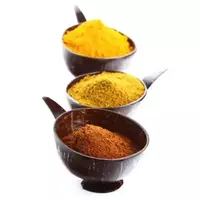Masala

Masala is an original spice blend that is included in most of the national cuisine of India, Nepal and Tibet. There are enough varieties of seasoning that vary in the composition of masala and the method of use. For example, tandoori masala is used to prepare dishes in an old Indian oven tandur or tandyr. For dishes that have a sharp taste, they use garam masala. There is also chaat-masala and panch-masala, which is added to vegetable dishes and a special spicy mixture for hot masala tea with coconut milk.
Masala is considered an ancient spice that has been used in Asian states for many centuries. Since the middle of the last century, masala spice has become popular in Europe and the United States. Masala usually includes the following ingredients: ground white and black pepper, curry, pippali pepper, cumin, bay leaf and cloves, as well as cardamom, cumin or zira, nutmeg, badyan and cinnamon. Moreover, this is only a small part of the initial ingredients, which can be changed or supplemented depending on the taste preferences of residents of a certain region.
Masala composition
The composition of masala may differ depending on the type of spice. For example, mung beans and chili peppers are used for chaat masala. Tanduri masala includes garam masala, as well as cayenne pepper and lemon juice. It is believed that all ingredients for masala must be ground just before the spice mixture is made. This will preserve the rich taste and aroma of each component ingredient of masala. The beneficial properties of masala are determined by the initial composition of the seasoning, which contains a huge amount of vitamins and minerals.
Masala benefits
Usually, before eating, the masala spice mixture is mixed with melted Indian oil called gi, then finely chopped onions and garlic are added, as well as coconut milk. Such a mixture is added to soups, fish and meat dishes, and is also used as a marinade. The healing properties of masala have long been used in the traditional Indian medicine of Ayurverda for the prevention and treatment of many diseases. It is believed that the main benefit of masala lies in the composition of the original ingredients of the spice.
Mmnogravy in a combination of herbs and spices, which is used to prepare masala, simply cannot but stand out for its useful vitamin-mineral composition. The benefits of masala for the human body are expressed in positive effects on the digestive and immune systems. Masala has antibacterial properties and prevents the development of most viral infections. Every Indian starts and ends their day with masala tea, which is considered an excellent invigorating and strengthening drink.
masal 379 kKal
Energy value of masal (Ratio of proteins, fats, carbohydrates - ju):
Proteins: 15 g (~ 60 kCal)
Fats: 15g (~ 135 kCal)
Carbohydrates: 45g (~ 180kCal)
Energy ratio (bj | y): 16% | 36% | 47%
 Español
Español Français
Français Português
Português Русский
Русский 简体中文
简体中文 繁體中文
繁體中文 日本語
日本語 한국어
한국어 العربية
العربية Türkçe
Türkçe Қазақ
Қазақ Deutsch
Deutsch Italiano
Italiano Українська
Українська
